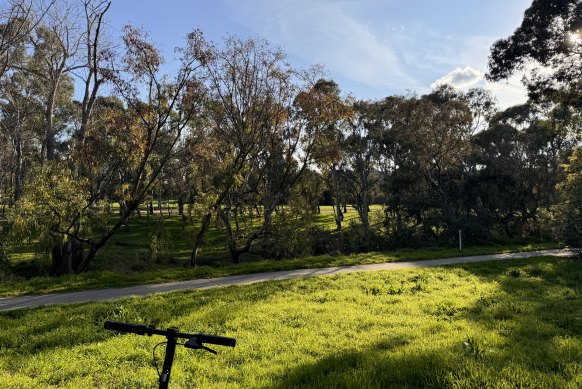
That includes which bike lanes are great and which are terrifying, how Google Maps is awful at knowing the difference (I’ve started using an app called Komoot to plan routes), and the pleasure of all the fun micro-interactions you get to have with other people going about their day outdoors - as they blindly walk backwards onto a bike path, or struggle to overtake you and then slow down.
Generally, I leave as the sun’s coming up so I can arrive at work early and leave early, avoiding the rush (although I did initially underestimate my need for cold weather gear), and large portions of the commute are peaceful.
I avoid the CBD on the way home to take the Capital City Trail, which is a beautiful way to breathe in a side of Melbourne I don’t often see, even if some inclines make it tough and the 2-metre clearance tunnels threaten to decapitate me.

I can stop here for a bit on the way home and still be faster than the peak-hour tram.Credit: Tim Biggs
Other trails I’ve taken have been far too narrow for two bikes side-by-side, let alone a scooter. Which is all to say scooters are a great but imperfect match for our existing bike infrastructure (imperfect as it is), and tweaks or guidance are probably going to be required as the number of scooters increases.
Sticking to the speed limit
Loading
I have also considered that I may be the only rider in the city who realises (or perhaps the only one who cares) that the speed limit for e-scooters in Victoria is 20 km/h.
Obviously, my perception is skewed – it stands to reason that I wouldn’t come across others going 20 since neither one of us is going to pass the other – but multiple times on every single trip, I’m overtaken by an e-scooter going much faster than me. And just to be clear these aren’t the joyriding youths you might imagine from media reports, they’re adult professionals like me.
My scooter, as configured by the manufacturer, can go up to 25 km/h. If it were capable of going faster it would be illegal to ride in public in Australia, yet most of the speeders I’ve seen are easily exceeding that.
This indicates that the scooters are either overseas models or have been modified at home using custom firmware updates, which is not difficult.
Being forced to go 20 in Victoria does mean you’re generally the slowest vehicle on any path, and I imagine that’s mostly true in the states that allow 25 as well. But by dodging the law to go as fast as they like, some riders do clearly make things more dangerous for everyone.
Scooters are nowhere near as stable as motorcycles, and many don’t have suspension (and this goes double for all you riders of electric skateboards and self-balancing one-wheeled vehicles, which are definitively not legal).
I, fortunately, haven’t had any crashes or incidents, but you can feel how a bit of uneven road or an unexpected bump can give you wobbles if you don’t see it ahead of time and shift your weight back. Similarly, I can see how braking heavily from speed would move your body forward in a way that would make it difficult to keep control.
Since I bought a scooter, I’m often recommended Reddit posts from scooter communities, and they’re almost all about people having horrific accidents. Of course, they’re also mostly from America and tend to be the result of going anywhere between 50 km/h and 100 km/h on the road, but it makes clear how early we are in figuring out where the limits should be, so starting at a low legal speed might be for the best.
Loading
Which brings me to some specific thoughts about rental scooters. Even though I’ve spotted some speeders on quiet bike paths, I’ve yet to see a single person being overtly reckless or dangerous on their own e-scooter. But, like most people, I have seen helmetless fools speeding along the footpaths in the city on a Lime. This, to me, doesn’t say we should ban rental scooters, which can give people access to the same freedom to get around as a bought scooter but without the need to charge, lock and maintain it. It says we should figure out how to make people care more.
I’m not going to leave my $1300 scooter lying on a footpath or risk smashing the fenders by hitting speed bumps too aggressively. So why not hold renters to account for these actions monetarily as well?
Impose a card hold. Install cameras to detect footpath riding and helmets. Provide clear resources to ensure people understand the rules. Maybe limit riding for new renters so they have the best chance of getting acclimated.
I don’t want to dismiss the danger posed by a reckless or inexperienced person jumping on a scooter and blazing down a footpath at full speed, and I know the above won’t stop people who are determined to break the rules.
But I also don’t want individual illegal actions to overshadow the potential good of these devices, which afford people the freedom to explore and travel across their cities and communities without relying on cars, public transport routes or the skill and physical capabilities required to use a bike.
Get news and reviews on technology, gadgets and gaming in our Technology newsletter every Friday. Sign up here.









 Add Category
Add Category